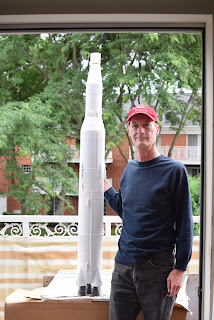I first checked out any pics on the web I could find that showed the details on the command module and recovery tower. The instructions left these details to the Modeler's discretion, only showing black on the rocket bells on the escape tower rockets. Even at 1/70 scale, the details on the command module were quite fine, and as I fashioned my detail plan, one always had to remember that with such fine details, there will be a lot of " that dosen't look quite right", so with some thinner and a soft cloth, it was wiped away, so I could try another time. (the reds and black were hard, because, being three of them, if one looked right, the other two looked off, and so on, until all three looked good enough.
I also used a wash, which brought out the details of the CM, without looking like it was painted, merely bringing out the highlights, giving it a 'worked on' look, a look that I felt most resembled the finish it had on launch day.
These details were done with Testor Enamels, which were forgiving to a redo, and when dry, stood up to the Mr. Hobby UV Clear that I was using as a topcoat before and after the decal placement.
The Wash.
I used a dropper to put an amount of thinner that was approx. 3/1 in an appropriate small paint tray, then I used a dropper to mix into it a combination of aluminum, while and flat black Testor enamel paints until the color looked good. It is a wash, so the point is to use the capillary action of the pigmented thinner to flow around the details, without leaving a noticeable 'paint-like' finish. If there was too much pigment, dip your brush into clean thinner, and brush away the pigments until you get a nice 'worked on' look, that let the details pop out, without diminishing the white of the molded part.
The wash will collect in places, but just use the brush, blotted on a paper towel, to 'wick' away any wash that accumulates in those places. What you are aiming for, is a nice even, 'contrasting' effect. less is best, so dip your brush into the clear thinner, and 'wash' away any places that look too painted on.. What you are looking for, is a surface that looks, off-white, with the struts and other details highlighted.
Before wash and color. *Pic Courtesy Apogeerockets.com
Notice the details, and how the camera flash made them stand out. I will be doing the same thing with the wash, and adding some details with colors. The shadows created by the flash does much the same thing that a wash does, bringing out the highlights in the flat colored styrene molded piece.
After wash and color.
The wash helps to make the painted details stand out a bit more. Now it is ready for the lacquer clear coat, which will make it easier to apply the decals.
After the clear.
The clear coat will mute the wash a bit, which makes the overall effect that much nicer. Remember, clear coat only after the colors are dry, using several light mist coats. The Lacquer will hold the enamels, just make sure you use mist coats, only after the clear has enough time to tack up, but not completely dry between coats. Remember to keep the wash to places that need it, less is best, as you can see the cleaner white portion that the Launch Escape Tower is attached to. Clean lines help the wash stand out, maximizing the effect.
Now that the Command Module is finished, the next post will tackle the Service Module. I had a hard time deciding how to tackle that detail job, since the wrap looked so good by itself.






























